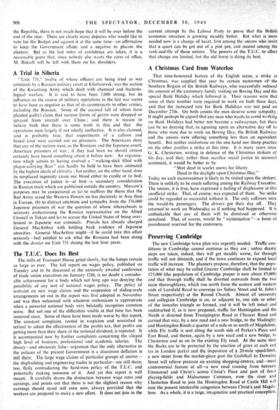Preserving Cambridge
The new Cambridge town plan was urgently needed. Traffic con- ditions in Cambridge cannot continue as they are ; unless drastic steps are taken, indeed, they will get steadily worse, for through traffic will not diminish, and if the town continues to expand local traffic will increase. The planners propose, therefore, that thc popu- lation of what may be called Greater Cambridge shall be limited to 125,000 (the population of Cambridge proper is now about 85,000) and that through traffic shall be diverted outwards from the two main thoroughfares, which run north from the eastern and western ends of Lensfield Road to converge (as Sidney Street and St. John's Street respectively) at the Round Church. Almost all university and collegiate Cambridge is on, or adjacent to, one side or other of the isosceles triangle so formed, and it will be left intact and undisturbed if, as is now proposed, traffic for Huntingdon and the North is diverted from Tnimpington Road at Chaucer Road and carried that way, by a new road and a new bridge, to the Madingley and Huntingdon Roads a quarter of a mile or so north of Magdalene, while Ely traffic is sent along the south side of Parker's Piece and East Road, and thence, again by a new road and a new bridge, to Chesterton and so on to the existing Ely road. At the same time the Backs are to be protected by the erection of gates at each end (as in London parks) and the imposition of a 20-mile speed-limit, a new street from the market-place past the Guildhall to Downing Street will relieve pressure on existing shopping-centres, and—most controversial feature of all—a new road running from between Emmanuel and Christ's across Christ's Piece and part of Jesus playing-fields and Midsummer Common, over the river and Chesterton Road to join the Huntingdon Road at Castle Hill will ease the present intolerable congestion between Christ's and Magda- lene. As a whole, it is a large, imaginative and practical conception.






























 Previous page
Previous page